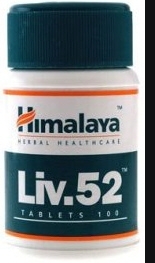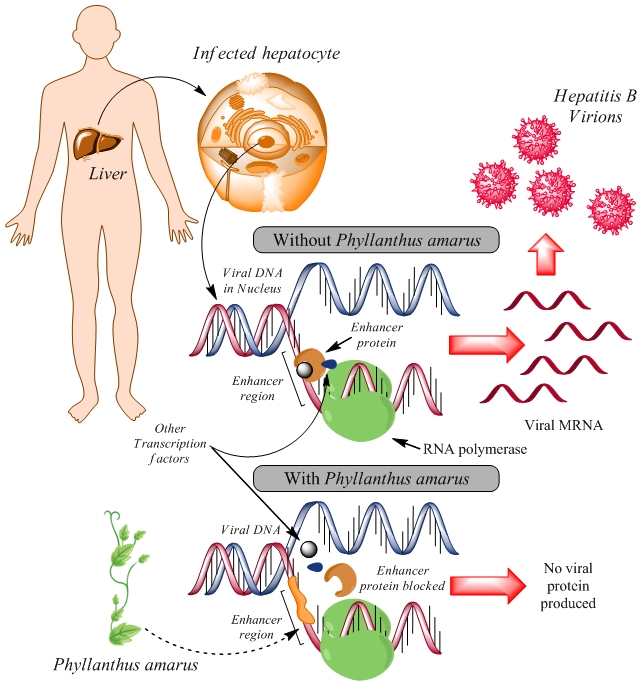Hepatitis B VirusContents Treatment: Currently on the market, we hear of many natural Hepatitis B cures. Let's look at a few and discuss their impact on the body. Milk Thistle: This herb is known to increase liver cell metabolism. This means that all the cellular processes that occur in the liver cell on a regular basis are up-regulated when taking this supplement. For example, if the liver cell is required to make a certain protein, this herb will increase the efficiency of that process by increasing the speed of production. This does not necessarily mean it will increase the responsiveness of one's immune system and cure infected cells; however, it can help the liver in certain conditions. Liv52: Phyllanthus amarus: This is by-far the most promising natural cure for chronic hepatitis B. According to several studies, this plant (herb) is said to have curative properties by suppressing transcription of hepatitis B virus messenger RNA (mRNA) (Ott et al., 1997). It does this by inhibiting hepatitis B virus enhancer I activity. Within the virus' genome, there are enhancer regions where enhancer-binding proteins, called transcription factors, attach to and allow the virus' DNA to be copied. In other words, these transcription factors "enhance" the viral replication process by binding to these enhancer DNA sequences. This herb down-regulates transcription of hepatitis B virus mRNA (the precursor of viral proteins) by a specific mechanism involving the interactions between hepatitis B virus enhancer I region and transcription factors (Figure 5) (Ott et al., 1997). Said differently, this natural chemical compound blocks the binding of transcription factors with enhancer DNA, and as a result, prevents the production of hepatitis B mRNA. Other studies have shown that an aqueous extract of Phyllanthus amarus inhibits endogenous hepatitis B viral polymerase and binds to the surface antigen of hepatitis B virus in vitro (Venkateswaran et al., 1987). Compared to most FDA approved hepatitis B treatments such as Entecavir, this herb is relatively inexpensive. Figure 5. The biochemical effect of Phyllanthus amarus on DNA regulation. Click to enlarge Moreover, if you are taking FDA-approved medicine based on the science of interrupting DNA replication, such as entecavir or adefovir dipivoxil, you should not expect to be cured after your next blood test. However, these drugs are very effective at halting the spread of the virus in the liver and should generally help the recipient live a long, normal life. The only drawback is that these drugs must be taken daily and that the virus, depending on its strength and strain, could eventually find other ways to replicate and resist the medicine. Since these drugs are nucleotide-based, one could also experience an increase in uric acid production (a by-product of nucleotide metabolism), resulting in the production of sodium urate - the main cause of renal stones. Over a long period of time, a buildup of sodium urate destructs the kidneys, preventing them from effectively filtering out the blood. This is why the kidneys are constantly monitored when a person takes these drugs. Overall, since the positives heavily outweigh the negatives (i.e. liver cancer versus possible kidney stones production), as long as you can afford these drugs, you should have nothing to worry about. Baron, S. (1996). Medical Microbiology (4th ed.). Büchen-Osmond C. (2006). Hepadnaviridae: The Universal Virus Database. ICTVdB Management. Accessed on: November 02, 2008. http://www.ncbi.nlm.nih.gov/ICTVdb/ICTVdB. Buendia, M.A. (1998). Hepatitis B viruses and carcerogenesis.Biomedicine & Pharmacotherary, 52: 34-43. Langley, D.R., Walsh, A.W. et al. (2007). Inhibition of Hepatitis B Virus Polymerase by Entecavir. Journal of Virology, 81(8): 3992-4001. Ott, M. Thyagarajan, S.P., & Gupta, S. (1997) Phyllanthus amarus suppresses hepatitis B virus by interrupting interactions between HBV enchancer I and cellular transcription factors. European Journal of Clinical Investigations, 27: 908-915. Venkateswaran, P.S., Millman, I, & Blumberg, B.S. (1987). Effects of an extract from Phyllanthus niruri on hepatitis B and woodchuck hepatitis viruses: in vitro and in vivo studies. The Proceedings of the National Academy of Sciences, 84(1): 274-278.
|

 The combination of herbs found in
this supplement is said to contain potent antioxidant
properties. Its marketers claim that it can neutralize all
kinds of toxins and poisons from food, water, air, and
medication. However, does it chemically stop hepatitis B virus from
replicating? The simple answer to this question is No. Remember, the human body produces its own
antioxidants and we obtain antioxidants, similar to the ones
found in this supplement, on a regular basis through our
diet.
The combination of herbs found in
this supplement is said to contain potent antioxidant
properties. Its marketers claim that it can neutralize all
kinds of toxins and poisons from food, water, air, and
medication. However, does it chemically stop hepatitis B virus from
replicating? The simple answer to this question is No. Remember, the human body produces its own
antioxidants and we obtain antioxidants, similar to the ones
found in this supplement, on a regular basis through our
diet.
